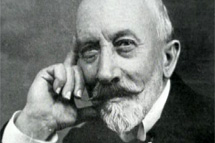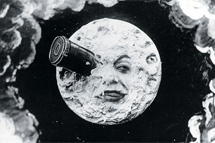 Georges Méliès (December 8, 1861 — January 21, 1938), full name Marie Georges Jean Méliès, is a unique person, one of the founders of the world filmmaking. He was a French actor, director, illusionist, inventor of basic film methods, and one of the most productive directors, who made more than five hundred movies.
Georges Méliès (December 8, 1861 — January 21, 1938), full name Marie Georges Jean Méliès, is a unique person, one of the founders of the world filmmaking. He was a French actor, director, illusionist, inventor of basic film methods, and one of the most productive directors, who made more than five hundred movies.
Méliès was born in Paris in the family of a manufacturer. Being a wealthy man, he spent much time on his hobbies, among which the main place was given to theatre and art of stage magic. As an illusionist he performed at the Theatre Robert-Houdin.
In 1895 Méliès saw one of the first Lumière brothers’ demonstrations, and at once became interested in filmmaking. He did not manage to buy a camera-projector created by the Lumières (he offered much money, but the brothers refused to sell it, because they tried to keep monopoly on the new entertainment), Méliès found the chance to get a similar camera of English production and started to experiment actively.
 Already in 1896 he found the way of creating the first special effects, based on stop-trick, stop-frame process, double and multiple exposure, time-lapse photography, masking and other tricks. In 1897 Méliès founded his own studio Star Film in his manor in Montreux and started an active production of short films.
Already in 1896 he found the way of creating the first special effects, based on stop-trick, stop-frame process, double and multiple exposure, time-lapse photography, masking and other tricks. In 1897 Méliès founded his own studio Star Film in his manor in Montreux and started an active production of short films.
Many Méliès’s films are made as theater shows with special effects. Méliès wrote scripts himself, developed stage sets and elaborated mise-en-scenes. For his films a minimal “frame depth” (the whole scene took place on stage) and motionless camera are characteristic.
 Méliès also made a “pseudochronicle” — stage plots, reproducing real events for the audience. For example, some of his famous short films are The Dreyfus Affair (1899), The Coronation of Edward VII (1902) and others. For some of them, as for Éruption volcanique à la Martinique (1902), Méliès used special effects, too.
Méliès also made a “pseudochronicle” — stage plots, reproducing real events for the audience. For example, some of his famous short films are The Dreyfus Affair (1899), The Coronation of Edward VII (1902) and others. For some of them, as for Éruption volcanique à la Martinique (1902), Méliès used special effects, too.
From 1896 to 1914 Méliès made more than 500 movies of duration from one to 40 minutes. Perhaps, among his works the most famous is A Trip to the Moon (1902) — the first sci-fi movie in the history of cinematograph.
Méliès tried to earn his living by selling copies of his movies to cinemas, but the largest market — the American one — turned out to be closed for him, as Thomas A. Edison considered himself the owner of all American patent rights on filmmaking technologies, and thought that he had the right to copy and sell for demonstration any movie, which was made without his sanction — including all Méliès’s movies. As a result, Méliès got almost nothing for demonstration of his movies in the USA, and in 1914 he had to sell his studio. He burnt the negatives of his movies in a fit of rage.
Méliès worked as a toy salesman at Montparnasse for a long time. No one remembered his contribution to the development of filmmaking until 1932, when the  Cinema Society gave home to him, a complete bankrupt, in Château d’Orly, where Méliès lived the rest of his life.
Cinema Society gave home to him, a complete bankrupt, in Château d’Orly, where Méliès lived the rest of his life.
Méliès was awarded the Légion d’honneur for his achievements. He lived the rest of his life in the home for elderly actors, and died in Paris. Méliès was buried in the Père Lachaise Cemetery.
The contribution of Méliès to cinema history is the subject of the 2007 illustrated novel The Invention of Hugo Cabret by Brian Selznick, and Martin Scorsese's 2011 film adaptation of it as Hugo with Ben Kingsley playing Méliès.
Based on Wikipedia